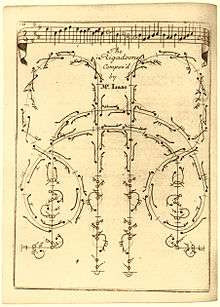Rigaudon

The rigaudon (also spelled rigadon, rigadoon) is a French baroque dance with a lively duple metre. The music is similar to that of a bourrée, but the rigaudon is rhythmically simpler with regular phrases (eight measure phrases are most common). It originated as a sprightly 17th-century French folk dance for couples. Traditionally, the folkdance was associated with the provinces of Vavarais, Languedoc, Dauphiné, and Provence in southern France, and it became popular as a court dance during the reign of Louis XIV (Little 2001). Its hopping steps were adopted by the skillful dancers of the French and English courts, where it remained fashionable through the 18th century. By the close of the 18th century, however, it had given way in popularity as a ballroom dance (along with the passepied, bourrée, and gigue) to the minuet (Cunningham Woods & 1895–96, 93).
Sources
- Cunningham Woods, Francis. 1895–96. "A Brief Survey of the Dances Popular in England during the Eighteenth Century". Proceedings of the Musical Association, 22nd Session:89-109.
- Little, Meredith Ellis. 2001. "Rigaudon". The New Grove Dictionary of Music and Musicians, second edition, edited by Stanley Sadie and John Tyrrell. London: Macmillan Publishers.
Further reading
- Anon. 1851. "Rigadoon". Encyclopædia Americana, 1851 edition, edited by Francis Lieber, 39. Philadelphia: Blanchard and Lea.
- Guilcher, Jean-Michel. 1984. "Le domaine du rigodon: Une province originale de la danse". Le monde alpin et rhodanien 12, nos. 1–2 (Chants et danses de tradition): 7–71. ISSN 0758-4431
- Hammond, Sandra Noll. 1992. "Steps through Time: Selected Dance Vocabulary of the Eighteenth and Nineteenth Centuries". Dance Research 10, no. 2 (Fall): 93–108. ISSN 0264-2875
- Mather, Betty Bang. 1987. Dance Rhythms of the French Baroque: A Handbook for Performance. Bloomington: Indiana University Press. ISBN 0-253-31606-5.
- Mazellier, Patrick. 2003. "Feldforschungen in der Dauphiné und im Vivarais und ihre Umsetzung im Musikschulunterricht". In Musikpädagogik und Volksmusikforschung: Chancen einer Zusammenarbeit—Symposion zum 70. Geburtstag von Josef Sulz, edited by Thomas Nußbaumer and Monika Oebelsberger, 65–87. Innsbrucker Hochschulschriften B: Musikalische Volkskunde, no. 5. Anif-Salzburg: Müller-Speiser. ISBN 3-85145-085-X.